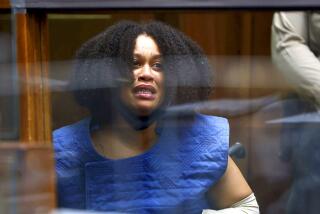Jumping to the Edge of Death, Teen Now Tries to Find Out Why
After she had everything ready--had dropped off her brother, gathered $2.50 for the toll, put the goodbye letter on the seat beside her--she hit traffic on the bridge. It was maddening.
A walkathon, of all things. A walkathon--thousands of people--blocking one whole span of the Chesapeake Bay Bridge. Below, a boat race was gearing up. So she waited. She’d been waiting all day, all junior year, really, since she’d come to the conclusion that life held no sanctuary for her.
On that busy day, Brandi Care, 17, finally made it onto the bridge and parked her dad’s white van. She took three steps up the railing and flung herself into the bay--legs splayed, hurtling 104 feet in 2 1/2 seconds--thinking, “This is it.”
Except it wasn’t.
Somehow she survived, because of physics or trained swimmer’s instincts or God’s outstretched hand. She survived to confront the gratitude and shame that many of her peers do not when they slash or swallow or shoot or leap their way to oblivion.
For 30,000 people a year, there is no epilogue. Suicide, more common than homicide, has become the third-leading cause of death for people ages 15 to 24, and the second for college students.
In July, Surgeon General David Satcher proclaimed suicide “a serious public health problem.” The Senate Appropriations Committee will hold hearings after January. Eminent psychiatrist Kay Redfield Jamison has just released a riveting book on suicide--including her own attempt--calling for communities, schools and homes to do more to prevent it.
Care had been a pageant girl, a National Honor Society member, a field hockey player, junior class president. Why, on May 3, 1998, did she want to kill herself?
“I want to do it without thought,” Brandi wrote in a spiral-bound notebook that day. “Off I go without anybody able to ask me questions.”
But she was given a second chance and, in a sense, so are we.
We are given the one thing that teen suicides, in their youth and impulsiveness, have so little of: time. Time to ask questions.
*
Born in 1981, Brandi grew into a warm, confident girl with three older brothers who acquired friends easily. She entered state-level pageants in junior high school and was student government president in seventh and eighth grades. Sophomore year, she was captain of her field hockey team and homecoming princess.
“She just always took on a lot, even when it wasn’t asked of her,” says close friend Sharon Molofsky, who has lived near Brandi since 1991. Friend Casey Hepburn says Brandi was the one to whom friends turned for advice, the one with “a solid head on her shoulders.”
“I always felt that I was a step ahead, intelligence-wise, experience-wise,” Brandi says. “I always had advice. I never felt stumped.”
*
It rolled in gradually, thick and noxious, so by the time the cloud of depression surrounded her, she had forgotten the sight of a blue sky.
Perhaps it was simply a matter of time. Brandi’s mother, Cheryl Care, who had taken the antidepressant Zoloft for years, says her own mother had been hospitalized for depression. Brandi’s depression was not dramatic, not punctuated by wrist scars or hotline calls. By many accounts--her own, her family’s, her friends’--it was almost without any outward cries for help.
Brandi was a junior when she began to feel an incessant desire to sleep. Some days she came home from school, fell into bed, woke for dinner, then went to bed again. She fell asleep in class. Her mother thought this was little more than the biorhythms of an active teenager.
Sometimes she forgot things. She’d be reading a textbook, and by the time she got to the bottom of the page, she’d have no idea what she’d just read. Certain thoughts crowded in.
“I just started feeling--I started feeling lonely, empty and just overwhelmed.”
Brandi now says a number of things conspired to trigger the depression. Friends who had depended on her seemed to move into their own and need her less. Math and biology became hard for her. She believed her hockey skills had deteriorated. She’d always felt like a special gift. Now that conviction was fading.
“I started feeling like I wasn’t pleasing people as much,” she says. “The accomplishments didn’t feel like enough.”
Like a bird beating against a windowpane, she could think of only one way out. She came to feel that God was now telling her, “Brandi, you’ve reached your full potential. It’s time for you to go.”
The reasons might sound minor for such a drastic conclusion, but distortion is a trick of the depressive mind.
Depression isn’t the only cause of suicidal thinking, though it is the most common. As Jamison documents in her book “Night Falls Fast,” the vast majority of those who commit suicide suffer from an array of psychiatric illnesses like manic depression or schizophrenia, or from addiction problems.
While the elderly, particularly white males, are most likely to commit suicide, in certain groups the growth rate has reached what the surgeon general calls “epidemic proportions.” The suicide rate for those between ages 15 and 19 rose precipitously after the mid-’50s, though it--like suicides on the whole--leveled off in recent years. And between 1980 and 1996, the rates rose 100% among those 10 to 14, and 105 percent for black male teenagers, though those numbers are relatively small.
Many factors are pushing the young to the breaking point, Jamison writes. Guns, the most common method, are easier to get. The age when children reach puberty has dropped, making them more vulnerable to mental illness. Kids drink and use drugs at a younger age. Medical examiners may be increasingly accurate about reporting suicide for what it is.
Brandi says that if she’d realized that what was besieging her was a diagnosable illness that’s treatable “80 to 90 percent of the time,” according to Surgeon General Satcher, she might have sought help. But the symptoms felt more like fate. “I just felt so helpless,” she says. “Why go and spill all these problems out when they’re not going to be able to be solved?”
“I don’t think people expect to get sick that way,” says Satcher. “People don’t look at depression and mood disorders the same way they look at blood sugar.”
“What you want to do,” says Jamison, “is create a climate in a school system and in a home where people talk openly in advance of symptoms.”
Instead, for Brandi, there came fleeting imaginations of suicide that turned into earnest dialogues over when and how.
*
It was a Sunday. She hated Sundays, the way they warned of the week ahead, more of the same dreariness.
The night before, there was a party for Brandi’s 17th birthday.
Alone, trying to read, she couldn’t block out a sense of doom. Marriage, children, the future that had always been promising, seemed blank. She thought, “I just don’t care if I have kids anymore.”
She grabbed her notebook to write out her feelings. And as she wrote, laying out the dimensions of despair and the possible methods of her own destruction, the Bay Bridge presented itself. It seemed easy, final, within reach. All her thoughts converged into: Do it now.
*
She was going 56 mph when she hit. The water was cold but not wintry cold, and seemed so deep she thought, “I guess I’ll die down here.” But her strong swimmer’s body rose to the top, her socks and sandals still on. Around her, she could see only water. Panic and pain set in. “I felt totally alone and helpless.”
It wasn’t a question of whether she wanted to live or die--pure instinct took over. She screamed, a scream so high-pitched she can still hear it in her head.
A boater picked her up and she was flown to a shock trauma center.
She had a tear in her pelvic area that had to be sewn up, and bruises on her thighs so bad she could barely sit for weeks. The physician in chief, Thomas Scalea, was amazed. Others have died jumping from lesser heights.
Her family got the news. Those moments of shock and bafflement are etched in their minds.
Her father was the first to reach her hospital bed. “I remember crying. . . . I remember saying, ‘Brandi, if there’s something I did or didn’t do, please let me know so I can help you.’ ”
Her brother Michael made a 90-minute trip home from college in 52 minutes. After seeing Brandi, he walked out of the hospital, sagged to the curb and wept.
In the aftermath was suspicion and fear. Once, during the summer after the attempt, Brandi and her mother fought. This is how Brandi remembers what her mother said: “I know that you jumped off that bridge to get away from me.”
Brandi and Brian, once “so tight,” aren’t as close anymore. Brian says he’s no longer angry, but his sister has changed. She’s tougher somehow.
Yet this isn’t even a whisper of what would have happened if Brandi had died. Suicide spreads guilt and destruction like spilled ink.
Seven months after Brandi jumped, a 16-year-old junior leapt off the Bay Bridge. Barbie Morgan was gregarious and academically successful. She jumped from the bridge’s highest point and fell about 182 feet. Her body was found a month later.
It inevitably raised the question of copycat suicides. Many researchers believe there is a link between highly publicized suicides and subsequent attempts.
*
There is sadness still.
After a brief stay in a psychiatric hospital, Brandi spent days lying on the couch. She entered therapy for a year and began taking the antidepressant Paxil. She got a job as a waitress. She tried to return to school in the fall, but in physics class she could only recall hours spent in biology thinking up ways to die. She decided on home schooling.
Recovery was slow and painful. At first, Brandi says, one thing that kept her from having suicidal thoughts was a fear of failing again.
But the waitressing gave her an ambition: to be a restaurant manager. Now, halfway into her freshman year at Virginia Tech, she lives in a small dorm room, her desk plastered with photographs of friends and family, a calendar reminding her of things to look forward to--friends’ visits, a vacation in Aruba. She has a boyfriend. She is in many ways her old self, friends say--funny, feisty, nurturing.
Once, she wanted to have answers for everyone’s problems, and the burden weighed her down. “All through my life, I was trying to save people,” she says.
Now she tries to answer her own needs. Though the dark moods still come, they aren’t as horrifying or frequent. She talks to close friends, who sometimes express frustration and despair, and she feels buffered by the shared experience.
Brandi is, after all, just one person--fallible, needy. She has learned she doesn’t have all the answers. And she doesn’t need to.
More to Read
Sign up for Essential California
The most important California stories and recommendations in your inbox every morning.
You may occasionally receive promotional content from the Los Angeles Times.










